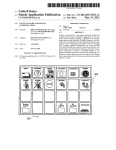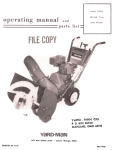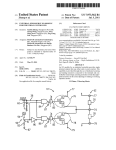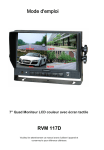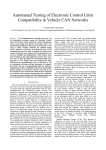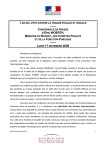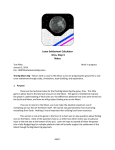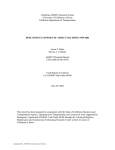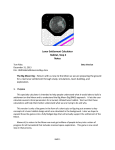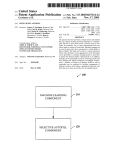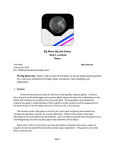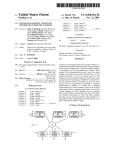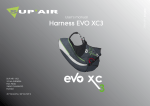Download Simulation of tuning effects for a servo driven mechatronic system
Transcript
US008255197B2 (12) United States Patent (10) Patent N0.: (45) Date of Patent: Pritchard et a]. (54) SIMULATION OF TUNING EFFECTS FOR A SERVO DRIVEN MECHATRONIC SYSTEM (56) US 8,255,197 B2 Aug. 28,2012 References Cited U.S. PATENT DOCUMENTS (75) Inventors: John Pritchard, Cedarburg, WI (US); Mark A. Chaffee, Chagrin Falls, OH (US); Graham Elvis, Norton Canes (GB) (73) Assignee: Rockwell Automation Technologies, Inc., May?eld Heights, OH (US) (*) Notice: 7,868,610 B2 * 2002/0111758 A1 * l/20ll 8/2002 2004/0030461 A1 * 2/2004 Flores et a1. 2004/0049368 A1 * 3/2004 Hamm et a1. .. 2004/0144177 A1 * 7/2004 Flock et a1. ...... .. 2006/0048015 A1 * 3/2006 Bardelang et a1. . 2006/0184280 A1 * 8/2006 Oddsson et a1. 2007/0067678 A1 * 2007/0283188 A1 * Subject to any disclaimer, the term of this patent is extended or adjusted under 35 U.S.C. 154(b) by 693 days. Velinsky et a1. ....... .. 324/20725 Wang et a1. ....... .. 702/79 2008/0033897 3/2007 Hosek et a1. 701/1 ....... 703/2 73/660 714/45 700/245 . . . .. 12/2007 BalZer et a1. ... ... ... ... 714/25 714/26 A1 * 2/2008 Lloyd 2008/0039959 A1 * 2/2008 Fister et a1. ................... .. 700/56 . . . .. 706/19 * cited by examiner Primary Examiner * Kandasamy Thangavelu (21) Appl. N0.: 12/242,403 (74) Attorney, Agent, or Firm *Turocy & Watson, LLP; Raymond Speroff (22) Filed: Sep. 30, 2008 (57) (65) Prior Publication Data US 2010/0082314 A1 ABSTRACT A servo driven mechatronic system simulator and analyzer utilizing precon?gured motion equipment pro?le databases Apr. 1, 2010 to predict the behavior of a motion system based on a user selected con?guration. The user can adjust the parameters and rerun the simulation and analysis many times in an e?i (51) Int. Cl. (52) (58) US. Cl. ........................... .. 703/13; 700/245; 714/25 desired system are reached. The user can then archive the Field of Classi?cation Search .............. .. 703/7, 13, system design and implement the system With a greater level of con?dence in the ability of the design to meet the require ments of the application. G06F 17/50 (2006.01) cient manner until the optimum operating conditions of the 703/2, 6; 700/56, 245; 706/19; 714/25, 714/26, 45; 702/79; 701/11; 324/207.25; 73/660 See application ?le for complete search history. 20 Claims, 14 Drawing Sheets 100 \ 112 -\ SIMULATION COMPONENT A INTERFACE COIVIPONENT / 102 11 V 110 \ ANALYSIS COMPONENT Y VISUALIZATION COIVIPONENT / 104 1 V V 108 _\ DATABASE ACCESS COMPONENT 106 US. Patent Aug. 28, 2012 Sheet 1 0114 US 8,255,197 B2 100 \ 112 \ SIMULATION COMPONENT 102 INTERFACE COMPONENT 110 \ I ANALYSIS COMPONENT VISUALIZATION COMPONENT 104 106 \ DATABASE ACCESS COMPONENT FIG. 1 US. Patent Aug. 28, 2012 US 8,255,197 B2 Sheet 2 0f 14 100 \ INTERFACE COIVIPONENT / 202 /— 102 USER INPUT 112 -\ /— 204 SIMULATION AUTOMATED COMPONENT INPUT 110 \ I ANALYSIS COMPONENT I 1 04 VTSUALIZATION COMPONENT I/ 106 108 \ DATABASE ACCESS COMPONENT FIG. 2 US. Patent Aug. 28, 2012 100 Sheet 3 0114 US 8,255,197 B2 INTERFACE COMPONENT / 202 _ USER INPUT 102 / /—204 AUTOMATED INPUT 112 \ SIMULATION COMPONENT VISUALIZATION COMPONENT /- 302 110 \ ANALYSIS DISPLAY DEVICE / 104 COMPONENT / 304 CONFIGURATION 10s \ DATABASE ACCEss COMPONENT 106 FIG. 3 US. Patent Aug. 28, 2012 Sheet 4 0f 14 US 8,255,197 B2 INTERFACE 100 \ COMPONENT /- 202 USER INPUT /_ 102 204 112 f \ 110 \ SIMULATION AUTOMATED COMPONENT |NPUT ANALYSIS VISUALIZATION COMPONENT COMPONENT /_ 302 DISPLAY DEVICE DATABASE ACCESS COMPONENT f 402 108 \ MOVE PROF||_E DATA / 104 304 / CONFIGURATION /- 404 MOTOR/DRIVE DATA 106 FIG. 4 US. Patent Aug. 28, 2012 Sheet 5 0f 14 US 8,255,197 B2 INTERFACE 100 \ / COMPONENT 102 /- 202 USER INPUT / /_ 204 SIMULATION AuTlgg’aTED / COMPONENT 104 ANALYSIS VISUALIZATION / COMPONENT COMPONENT <—> FORCE ANALYSIS '\— 502 AXIS STOP ANALYSIS '\~ 504 /- s02 DISPLAY DEVICE ,/ /_ 304 / CONFIGURATION RATIO/DESIGN 5 ANALYSIS ‘\~ 506 TOLERANCE I I ANALYSIS '\— 50s TORQUE 110 \ ANALYSIS ‘\— 510 108 DATABASE ACCESS POWER SUPPLY '\— 512 COMPONENT /- 402 <——> LIFE ESTIMATE .\_ 514 MOVE PROFILE / DATA /- 404 MECHANICAL LIMITATIONS MOTOR/DRIVE / ‘\~ 516 FIG. 5 DATA 106 US. Patent 100 Aug. 28, 2012 US 8,255,197 B2 Sheet 6 0f 14 \ SIMULATION COMPONENT INTERFACE COMPONENT /— 602 COMPLIANCE/ / BACKLASH 112 \ USER INPUT / /— 604 NETWORK ./ iiiiiiiiiiiiiiiiiiiiiiiiiiiiiiiii AUTOMATED INPUT /— 606 __________________________________ _, CONTROLLER / VISUALIZATION COMPONENT ANALYSIS ‘ COMPONENT FORCE , r 502 / DISPLAY / DEVICE ANALYSIS 504 AXIS STOP //_ CONFIGURATION / ANALYSIS ________________ RATIO/DESIGN ANALYSIS _€_'_' '_'_' '_'_' 1'.‘ LIL: l: l'll'l:' ‘i f- 5 106 _______________________________ ‘I /- 50s - TOLERANCE / ANALYSIS /— 510 TORQUE 110 \ ANALYSIS 108 / /— 512 POWER SUPPLY DATABASE ACCESS COMPONENT <—> LIFE ESTIMATE /f 514 MOvEDATA PROFILE / MOTOR/DRIVE / DATA FIG. 6 US. Patent 100 Aug. 28, 2012 Sheet 7 0f 14 US 8,255,197 B2 \ SIMULATION INTERFACE COMPONENT COMPONENT /- 602 egg/5mg? / 112 \ NETWORK / -------------------------------- 102 /- 202 USERINPUT v //_ 604 AUTOMATED ,//_ INPUT “4 606 CONTROLLER //_ / 104 VISUALIZATION COMPONENT DISPLAY /_ 302 / DEVICE ANALYSIS <—, COMPONENT FORCE /_ 304 //- 502 CONFIGURATION / ANALYSIS /— 504 AXIS STOP / ANALYSIS STORAGE ________________ .‘LL'LILL'LL'LL'LL'LL'LILLE‘E /_ V RAIL‘ZFYES'SGN MODEL __________________________________ _| STORAGE ................................. ,- 50s TOLERANCE 702 / ANALYSIS / 704 __________________________________ ‘I TORQUE 110 / 106 /- s10 / SYSTEM STORAGE ANALYSIS \ /- 512 POWER SUPPLY / V DATABASE ACCESS <—> COMPONENT 514 LIFE ESTIMATE 108 //_ f- 402 MOVEDATA PROFILE / MOTOR/DRIVE / DATA FIG. 7 US. Patent Aug. 28, 2012 Sheet 8 0f 14 US 8,255,197 B2 800 \ f 802 CONFIGURE AXIS / 804 CONFIGURE CYCLE PROFILE / 806 CONFIGURE MECHANISM / 808 CONFIGURE TRANSMISSION STAGES / 810 SELECT COMPONENTS FIG. 8 US. Patent Aug. 28, 2012 Sheet 9 0f 14 US 8,255,197 B2 900 \ / s12 SELECT COMPONENTS 902 MANUAL SEARCH? Y YES 4, MANUALLY SEARCH DATABASE AUTOMATICALLY SEARCH DATABASE FIG. 9 / 904 / 906 US. Patent Aug. 28, 2012 Sheet 10 0114 US 8,255,197 B2 1000 \ / s12 SELECT CONTPONENTS %\AXIS STOP DESIRE]? YES NO / 1004 CONFIGURE AXIS STOP / 1006 RUN SIMULATION FIG. 10 US. Patent Aug. 28, 2012 Sheet 11 0114 US 8,255,197 B2 2: ow: .l g: A @3“9m5o0 $32G cm: WgoE?sQbémO 6S:2m05% mi ouhm 5@082a5m w 02 :cD H ow: H Il. 3A: h US. Patent Aug. 28, 2012 Sheet 12 0114 US 8,255,197 B2 1200 [1210 l220\ CLIENT(S) SERVER(S) CLIENT DATA SERVER DATA STORE(S) COMNIUNICATION FRAMEWORK FIG. 12 US. Patent Aug. 28, 2012 Sheet 13 0f 14 US 8,255,197 B2 1300 [1310 CLIENTZ 131\ . . . CLIENTN-l /l3l0 1310\ CLIENT N CLIENT 1 COM VII 1 QICATION FRAMEWORK FIG. 13 US 8,255,197 B2 1 2 SIMULATION OF TUNING EFFECTS FORA SERVO DRIVEN MECHATRONIC SYSTEM simulation on other databases such as industrial controller con?guration databases and user de?ned databases. The described system and methods provides for simulations that are operationally fast enough to alloW many different equip ment designs and con?gurations to run before selecting ?nal design speci?cations. In another aspect, the system and meth ods simulate both mechanical and control behaviors alloWing TECHNICAL FIELD The subject invention relates generally to industrial control systems, and more particularly to motion simulation systems that interact With industrial control system databases based in for a more complete simulation leading to a better system part on selecting and analyzing motion components and design for the actual implementation. To the accomplishment of the foregoing and related ends, behaviors. certain illustrative aspects are described herein in connection BACKGROUND With the folloWing description and the annexed draWings. These aspects are indicative of various Ways Which can be practiced, all of Which are intended to be covered herein. Motion controllers are special-purpose computers utiliZed for controlling motors, drives, and other aspects of a mecha tronic system. Designing a system Where drive technology is utiliZed is dif?cult because of the complexities and unknowns involved in a motion system. For instance, What system load to motor inertia ratio is acceptable, hoW Will compliance and/ or backlash betWeen the load and the motor impact per Other advantages and novel features may become apparent from the folloWing detailed description When considered in conjunction With the draWings. motor, feedback, servo drive, controller and gain settings. Typically, determining ansWers to these questions involved building a prototype machine and conducting empirical tests FIG. 1 illustrates an embodiment of a visualiZation system for simulating the tuning effects of a servo driven mecha tronic system. 25 to collect data and determine the proper combinations of FIG. 3 illustrates an embodiment of a visualiZation system 30 FIG. 4 illustrates an embodiment of a visualiZation system 35 system has created market pressure for a system that can simulate a servo driven mechatronic system for alloWing the selection of components to build the system Without the necessity of prototyping the machinery or knoWing many of the system dynamics details. In another aspect, market pres for simulating the tuning effects of a servo driven mecha tronic system Where a database access component alloWs the selection and searching of system and user databases. FIG. 5 illustrates an embodiment of a visualiZation system 40 for simulating the tuning effects of a servo driven mecha tronic system Where an analysis component alloWs the selec tion, con?guration and analysis of equipment and con?gura sure requires ease of use of the simulation system With regard to knoWledge of servo driven systems. There is a need in the market for a system that is aWare of currently available hard Ware and con?gurations and does not require the user of the system to provide all the intelligence of What hardWare to select and What parameters to con?gure and their values. for simulating the tuning effects of a servo driven mecha tronic system Where a visualiZation component alloWs the selection, con?guration and display of servo driven mecha tronic system components. roW constraints of the general simulation softWare, the task Was dif?cult because of the requirement of large amounts of design information that Was unknoWn at design time. The large expense and speci?c requirements of this type of FIG. 2 illustrates an embodiment of a visualiZation system for simulating the tuning effects of a servo driven mecha tronic system Where an interface component alloWs the col lection of automated data and manual data. machinery and con?guration parameters. Another possibility for a feW designs included the use of general simulation softWare if the intended design ?t Within the constraints of the simulation software. Even for those designs meeting the nar BRIEF DESCRIPTION OF THE DRAWINGS 20 formance and What performance can be expected. The di?i culty in ansWering these and many other questions are related to the complex relationship betWeen load, mechanism, servo tion associated With a servo driven mechatronic system. FIG. 6 illustrates an embodiment of a visualiZation system 45 for simulating the tuning effects of a servo driven mecha tronic system Where a simulation component alloWs the visu aliZation system to present a model of the servo driven mecha tronic system in operation. SUMMARY The folloWing presents a simpli?ed summary in order to provide a basic understanding of some aspects described FIG. 7 illustrates an embodiment of a visualiZation system 50 herein. This summary is neither an extensive overvieW nor is intended to identify key/ critical elements or to delineate the scope of the various aspects described herein. Its sole purpose is to present some concepts in a simpli?ed form as a prelude to the more detailed description presented later. The innovation includes a system and methods to simulate the operation of a servo driven mechatronic system and alloW the tuning of the system based on the components either manually selected by the user from a database or automati for simulating the tuning effects of a servo driven mecha tronic system Where a storage component alloWs the visual iZation system to store precon?gured and user databases, simulation models and simulation results. FIG. 8 illustrates a methodology of a servo driven mecha 55 tronic system Where the user con?gures the components of the system. 60 FIG. 9 illustrates a methodology of a servo driven mecha tronic system Where the user decides on the type of database search to conduct. FIG. 10 illustrates a methodology of a servo driven mecha tronic system Where the user decides Whether to include an cally selected from the database by the system. The entire servo driven mechatronic system is represented graphically axis stop component before running the simulation. and run in a simulated mode to provide the user With design mechatronic system depicting a typical computing environ parameters and con?gurations alloWing successful matching of components and system operation. The system includes a precon?gured database for genera tion of the simulation and can also be con?gured to base the FIG. 11 illustrates an embodiment of the servo driven ment. 65 FIG. 12 illustrates an embodiment of the servo driven mechatronic system depicting the interactionbetWeen a servo driven mechatronic client and a database server. US 8,255,197 B2 4 3 mechatronic system depicting the interaction betWeen mul It is also noted that the interfaces described herein can include a Graphical User Interface (GUI) to interact With the tiple servo driven mechatronic clients. various components for providing industrial control informa FIG. 13 illustrates an embodiment of the servo driven tion to users. This can include substantially any type of appli FIG. 14 illustrates an embodiment of the servo driven cation that sends, retrieves, processes, and/or manipulates factory input data, receives, displays, formats, and/or com mechatronic system depicting a cascaded control loop struc ture. municates output data, and/or facilitates operation of the DETAILED DESCRIPTION enterprise. For example, such interfaces can also be associ ated With an engine, editor tool or Web broWser although other Systems and methods are provided enabling the user to con?gure a servo driven mechatronic system alloWing the user to select hardWare components and operating conditions from a database and simulate the operation of the servo driven mechatronic system. The simulation and analysis can infor type applications can be utiliZed. The GUI can include a mation can then be used to design a servo driven mechatronic system that meets the system requirements With a minimal data and sounds to facilitate operations With the interfaces. In addition, the GUI can also include a plurality of other inputs amount of lead time and expense. The user can also select a precon?gured servo driven mechatronic systems as a basis for or controls for adjusting and con?guring one or more aspects. This can include receiving user commands from a mouse, designing their intended system. The created servo driven mechatronic systems can be communicatively distributed to 20 other device such as a camera or video input to affect or display having one or more display objects (not shoWn) including such aspects as con?gurable icons, buttons, sliders, input boxes, selection options, menus, tabs and so forth hav ing multiple con?gurable dimensions, shapes, colors, text, keyboard, speech input, Web site, remote Web service and/or data servers or other servo driven mechatronic systems to modify operations of the GUI. provide a larger database of possible precon?gured process problem solutions. In one aspect of the subject disclosure, the precon?gured troller as used herein includes both PLCs and process con database represents the accumulation of servo driven system Additionally, it is also noted that the term industrial con 25 trollers from distributed control systems and can include functionality that can be shared across multiple components, knowledge collected from empirical system operation and systems, and or netWorks. One or more industrial controllers control system databases. In another aspect of the subject can communicate and cooperate With various netWork disclosure, as the servo driven mechatronic systems require change, the simulation system provides for a method of evalu ating neW equipment before it is purchased and added to the devices across a netWork. This can include substantially any 30 system. public networks. The industrial controller can also commu nicate to and control various other devices such as Input/ It is noted that as used in this application, terms such as “component,” “display,” “interface,” and the like are intended Output modules including Analog, Digital, Programmed/In to refer to a computer-related entity, either hardWare, a com bination of hardWare and softWare, softWare, or softWare in type of control, communications module, computer, I/O device, Human Machine Interface (HMI)) that communicate via the netWork Which includes control, automation, and/or 35 telligent I/O modules, other programmable controllers, execution as applied to an automation system for industrial communications modules, and the like. The netWork (not control. For example, a component may be, but is not limited shoWn) can include public netWorks such as the Internet, Intranets, and automation netWorks such as Control and to being, a process running on a processor, a processor, an object, an executable, a thread of execution, a program and a computer. By Way of illustration, both an application running 40 on a server and the server can be components. One or more components may reside Within a process and/or thread of execution and a component may be localiZed on one com puter and/or distributed betWeen tWo or more computers, industrial controllers, and/or modules communicating there 45 ration tools, monitoring tools, and/ or other devices. related entity referenced above. Referring initially to FIG. 1, a servo driven mechatronic 50 generally to the process of reasoning about or inferring states of the system, environment, user, and/or intent from a set of observations as captured via events and/or data. Captured data and events can include user data, device data, environ ment data, data from sensors, sensor data, application data, implicit and explicit data, etc. Inference can be employed to serial protocols, and so forth. In addition, the netWork devices can include various possibilities (hardWare and/or softWare components). These include components such as sWitches With virtual local area netWork (VLAN) capability, LANs, WANs, proxies, gateWays, routers, ?reWalls, virtual private netWork (VPN) devices, servers, clients, computers, con?gu With. Additionally, it is noted that as used in this application, terms such as “system user,” “user,” “operator” and the like are intended to refer to the person operating the computer As used herein, the term to “infer” or “inference” refer Information Protocol (CIP) netWorks including DeviceNet and ControlNet. Other netWorks include Ethernet, DH/DH+, Remote I/ O, Fieldbus, Modbus, Pro?bus, Wireless netWorks, visualiZation system 100 for analyZing the selected compo nents and simulating the operation of the servo driven mecha tronic system is depicted. The system provides a mechanism to design and test a servo driven mechatronic system Without the costly expense of prototyping the system or the lengthy 55 lead time to con?gure a generaliZed simulation softWare package to investigate Whether the selected components are identify a speci?c context or action, or can generate a prob operationally acceptable and compatible. ability distribution over states, for example. The inference can distribution over states of interest based on a consideration of 60 It is contemplated that the servo driven mechatronic visu aliZation system 100 can form at least part of a system devel opment visualiZation system, but is not limited thereto. For data and events. Inference can also refer to techniques example, the servo driven mechatronic visualiZation system be probabilistic, that is, the computation of a probability employed for composing higher-level events from a set of 100 can be employed to facilitate creating a servo driven events and/ or data. Such inference results in the construction close temporal proximity, and Whether the events and data mechatronic system related to automation control systems, devices, and/or associated equipment (collectively referred to herein as an automation device(s)) forming part of a produc tion environment. Servo driven mechatronic system 100 come from one or several event and data sources. includes interface component 102, visualiZation component of neW events or actions from a set of observed events and/or stored event data, Whether or not the events are correlated in 65 US 8,255,197 B2 5 6 104, storage component 106, database access component 108, analysis component 110 and simulation component 112. tion model to the storage database 106, the servo driven mechatronic system 100 can automatically update all other servo driven mechatronic systems containing the precon?g The interface component 102 is communicatively con nected to Input/ Output devices. The interface component 102 provides for object or information selection, input can corre spond to entry or modi?cation of data. Such input can affect ured transmission as a default selection. In this manner, the the con?guration, graphic display, reports and/ or automation ef?ciency of the overall servo driven mechatronic system design is improved because better default choices are avail able. If the particular transmission is selected at another loca devices. For instance, a user can select a motion application tion then the user at that location can select the precon?gured from the list of previously created applications or he can instruct the servo driven mechatronic visualization system 100 to create a neW application. Additionally or alternatively, transmission parameters Without the time consuming and costly step of analyzing the components. The database access component 108 provides methods and functionality alloWing the user access precon?gured motion component databases and user con?gured motion component databases. In one aspect, the precon?gured motion databases a user could modify axis parameters such as load type or actuator type. By Way of example and not limitation, the user could select a transmission by selecting the transmission type, and entering the ratio of transfer, the effective inertia, the ef?ciency With regards to torque-dependent losses and the friction torque. It should be noted that input need not come solely from a user, it can also be provided by an automatic model computation based on information in a database related to the selected transmission type. alloW the user to select standard commercially available com ponents for use in an analysis and simulation. In another aspect of the subject innovation, the user can create databases 20 The interface component 102 receives input concerning displayed objects and information. Interface component 102 aspect, the database access component alloWs the user to select precon?gured or user con?gured databases from other servo driven mechatronic systems communicatively con nected With the user’s system. can receive input from a user, Where user input can corre spond to object identi?cation, selection and/or interaction thereWith. Various identi?cation mechanisms can be 25 employed. For example, user input can be based on position ing and/or clicking of a mouse, stylus, or trackball, and/or depression of keys on a keyboard or keypad With respect to components of the servo driven mechatronic system 100. For example, this information includes motor parameters such as 30 made based on touching a graphical object. Other input devices are also contemplated including but not limited to gesture detection mechanisms (e.g., pointing, gazing . . . ) and voice recognition. The visualization component 104 presents the con?gura 35 tion screens to the user for selecting the components of the servo driven mechatronic visualization system 100. One or more of the con?guration displays contain data entry ?elds, buttons, check boxes or dropdoWn menus for selecting com ponents and their associated con?guration parameters. For The analysis component 110 provides the user the ability to analyze the data generated by the simulation. The analysis component presents information important to selecting the displayed information. Furthermore, the display device may be by a touch screen device such that identi?cation can be containing custom designed components for use in selecting components for the analysis and simulation. In another 40 but not limited to inertia ratio, peak torque and temperature rise. In another example, the information includes drive parameters such as but not limited to average amperes, peak amperes and bus volts. In another aspect, the user can make changes to the param eters associated With the selected components and perform another analysis based on the changes in the con?guration. This method results in the generation of different solutions for the design of the intended servo driven mechatronic system. After generating the different solutions the user can revieW and table mass. Additionally, the user can select an inclination the analysis of each solution and select the best solution and therefore the best components for the intended application. The simulation component 112 provides the user the abil ity to simulate the running of the servo driven mechatronic system based on the selected components and con?guration parameters. In another aspect, the simulation component 112 depicting the path of travel of the load. The storage component 106 provides the ability to archive precon?gured process motion application solutions, precon interacts With a database from a motion controller providing the user the ability to tune the selected components and their associated parameters to optimal conditions based on the example, the display graphic can have a section labeled “Volt age Selection” for the operator to con?gure the supply type, the voltage type and the nominal voltage. In another example, the user can con?gure the load data by entering the mass, the external force and the coe?icient of friction related to the load ?gured servo driven mechatronic visualization systems 45 50 including displays, reports and graphs and user con?gured components of the visualization system 100. Additionally, any databases created by the user are archived on the storage component and can be communicated to server data stores 1230 or other servo driven mechatronic visualization system clients 1310. In another aspect, servo driven mechatronic application data is maintained on the storage component 106 for future revieW With regards to creating neW precon?gured servo driven mechatronic systems 100 or updating existing servo Referring next to FIG. 2, the interface component 102 includes user input component 202 and automated input com ponent 204. In one aspect, user input component 202 provides the capability for a user to input manual data to select and 55 but not limited to a keyboard and mouse. For example, the user can add an actuator type mechanism component to the 60 can automatically transfer its database of precon?gured servo driven mechatronic systems 100 to other server data stores servo driven mechatronic system including the initial speci ?cation of parameters such as actuator type, pinion pitch circle diameter, pinion inertia, losses and table mass. At a later time, When simulations have provided initial information, the user, using the user input component 202, can add additional information or comments to the servo driven mechatronic based on a timed schedule an event such as the selection of With a particular transmission type and archives the applica con?gure a servo driven mechatronic system. The user can add this information manually With the input devices such as driven mechatronic systems 100. The storage component 106 similar components at another servo driven mechatronic sys tem. For example, if a user con?gures a parameter associated information provided by the databases. 65 system to further tune the servo driven mechatronic system or extend the solution to other aspects or machines of the pro cess. The enhanced solution can then be communicated to US 8,255,l97 B2 8 7 The move pro?le data component 402 provides the user other servers or servo driven mechatronic systems to decrease overall design time by providing greater insight into the servo access to the data associated With the movement characteris driven mechatronic system. In another aspect, the automated input component 204 provides the user the ability to automatically import motion tics of the selected drives, motors, actuators, transmissions and resistive brake modules, for any of the speci?ed compo application data. For example, the user can instruct the servo driven mechatronic system to import axis data. The user can data provides the simulator the characteristic information of the components alloWing the simulator the ability to calculate the behavior of the con?gured system and generate the data nents included in the simulation application. The use of this choose to import the selected axis data into the currently displayed motion application or into another motion applica necessary to analyZe the con?gured system to tune the com tion de?ned on the servo driven mechatronic system. In ponents for optimal operation. another aspect of the subject innovation, if the selected The motor/ drive data component 404 provides the user access to the data associated With the con?guration and motion application has more than one axis de?ned, the user operational requirements of the selected drives and motors. This data includes but is not limited to supply type, voltage can select the particular axis for application of the imported data. Referring next to FIG. 3, the visualiZation component 104 includes a display device component 302 and a con?guration component 304. In one aspect, the display device component 302 provides a device for rendering a graphic image alloWing the operator to monitor the simulation and analysis. A part of the graphic image menus and data entry ?elds for selecting servo driven mechatronic system components and entering type, nominal voltage, voltage tolerances, transmission type, transmission inertia, transmission ratio, transmission e?i ciency etc. As described previously, the use of this data pro vides the simulator the characteristic information of the com 20 con?guration data. nents for optimal operation. The servo driven mechatronic system also provides the user the ability to create and manage a plurality of motion applications on the current system or on netWork servers or 25 other servo driven mechatronic systems communicatively connected to the current system. It should be noted that the user can manually transfer the motion applications to or from another aspect of the subject innovation, the force analysis 30 35 the user’s con?guration or to a document in a Word processor 40 Con?guration component 304 can also alloW the con?gu ration of a motion application based on prede?ned templates. The prede?ned templates can be categoriZed as standard tem plates such as but not limited to press roll feed and cutter knife drive or as advanced templates such as but not limited to crank 45 and four-bar linkage. These templates provide a starting point for creating motion applications associated With typical motion operations. The templates can then be customiZed by the user to meet the user’s speci?c motion application. Upon options for using a drive controlled stop or a resistive brake module. In one aspect of the axis stop component 504, the user is presented a graphical representation of the decelera tion time and distance required based on a controlled stop by the drive. In another aspect of the axis stop component 504, the user can select to analyZe a resistive brake module by providing a start velocity based on a maximum application or maximum motor velocity and load data for the servo driven mechatronic system. The results of the selection are presented to the user in a graphical format is feasible, if not feasible then the user receives a message about What parameters to change 50 to alloW the use of a resistive brake module. In another aspect of the subject innovation, the ratio/design completion, the user can create neW templates based on the analysis component 506 provides the user the ability to inves ?nal con?guration thus creating a more accurate starting point for future simulation applications. tigate the effect of transmission ratio on servo driven mecha tronic system performance and to quickly choose an optimum Returning to the FIG. 4 of the draWings, the database access component 108 includes move pro?le data component 402 and motor/ drive data component 404. The database access component 108 provides the user the ability to interact With databases containing the information necessary to con duct a simulation of the selected components and perform an analysis based on the results of the simulation. In one aspect of the subject innovation, the database access component 108 the user chooses, the other segments can be revieWed and are presented to the user in order of descending peak force. In another aspect of the subject innovation, the axis stop component 504 presents the user a graphical analysis and motion application can be exported to a delimited text ?le of format. It should be noted that the described formats are exemplary and other formats are possible based on the user’ s indication. component 502 provides the user the ability to determine the order of the segments With regards to peak force. This analy sis directs the user to the appropriate segment for consider ation of design changes that Will have the greatest impact on servo driven mechatronic system ef?ciency of operation. If systems or servers based on events such as but not limited to a user changing some aspect of a motion application. In another aspect, the con?guration component 304 pro vides for exporting motion applications to different formats for use by other softWare applications. For example, the Referring noW to FIG. 5, the analysis component 110 includes a force analysis component 502, an axis stop analy sis component 504, a ratio/design analysis component 506, a tolerance analysis component 508, a torque analysis compo nent 510, a poWer supply component 512, mechanical limi tations component 516 and a life estimate component 514. In another servo driven mechatronic system or server or the servo driven mechatronic system can automatically transfer the motion applications to other servo driven mechatronic ponents alloWing the simulator the ability to calculate the behavior of the con?gured system and generate the data nec essary to analyZe the con?gured system to tune the compo 55 performance ratio. In one aspect the user is presented With a graphical representation of the gearbox ratio versus the per centage utiliZation. The user can then vary the gearbox ratio and observe the effect the variance of the gearbox ratio has With respect to percent utiliZation. In another aspect the sub 60 ject innovation, the ratio/design analysis component 506 pro vides the user a list of available gearboxes for selection foruse in the analysis. The user can then choose other gearboxes and alloWs the user to interact With databases associated With commercially available motors, drives, gearboxes and shunts. vary the gearbox ratio to further identify the optimal compo In another aspect of the subject innovation, the database nents to include in the servo driven mechatronic system access component 108 provides the user the ability to create custom designed motor databases for use in conducting simu lations of the selected components. 65 design. The tolerance analysis component 508, in another aspect of the subject innovation, provides the user the ability to con US 8,255,197 B2 9 10 ?gure tolerance bands for any servo driven mechatronic sys tem variables used in the analysis. These tolerance bands are evaluated as both ranges for input and determining if a par Referring noW to FIG. 6, the simulation component 112 includes a compliance/backlash component 602, a netWork component 604 and a controller component 606. The simu lation component 112 provides the capability to run the user’ s ticular application is marginal in its design. In one aspect of the tolerance analysis component 508, the con?gured servo driven mechatronic system as a simulation servo driven mechatronic system alloWs the user to con?gure and collect data useful in analyZing the feasibility, ef?ciency a tolerance analysis for the load With regards to parameters such as load mass, load thrust, load inclination and tempera and stability of the mechatronic system based on the compo nent selection. In one aspect, the compliance/backlash com ponent 602 provides the user With a mechanism to manually ture. The user can con?gure a loW and high value for each of these parameters and a number of steps betWeen the loW and tolerance analysis component 508, the user can con?gure a enter data for the compliance of the mechatronic system components and backlash data associated With the gearbox. In another aspect, the compliance/backlash component 112 can automatically include backlash data for the gearbox from the database in place of or in addition to the manual data provided by the user. The inclusion of compliance and back lash data alloWs the compliance/backlash component 602 in tolerance analysis for the actuator With regards to inertia, diameter, belt mass, table mass, losses, temperature and the concert With the simulation component 112 to calculate any predicted resonance characteristics of the mechatronic sys high values. In another aspect of the tolerance analysis com ponent 508, the servo driven mechatronic system alloWs the user to select an element of the velocity pro?le, con?gure its tolerance parameters and display the effect on the pro?le of the neWly con?gured parameters. In another aspect of the coe?icient of friction. The user can con?gure a loW and high value for each of these parameters and a number of steps betWeen the loW and high values. In another aspect of the subject innovation, the torque analysis component 510 provides the user the ability to deter mine the order of the segments With regards to peak torque. This analysis directs the user to the appropriate segment for consideration of design changes that Will have the greatest impact on servo driven mechatronic system ef?ciency of operation. If the user chooses, the other segments can be 20 manually entering netWork parameters associated With simu lating the operation of the mechatronic system. For example, 25 the user can enter the netWork update alloWing the netWork 30 component 604 to predict the behavior of the mechatronic system betWeen data samples. The user can adjust the entered update rate value in the simulator and run additional simula tions to determine if another netWork update rate Would lead to a mechatronic system With greater stability for the selected revieWed and are presented to the user in order of descending peak torque. tem. In many applications these constraints Will provide the limits of performance of the mechatronic system. The netWork component 604, in another aspect of the sub ject innovation, provides the user With a mechanism for components. In another aspect of the subject innovation, in combination In one aspect, the poWer supply component 512 alloWs the user to select system modules for multi axis servo driven mechatronic systems. In another aspect, the poWer supply With the user’s manually entered data, the netWork compo component 512 alloWs the user to select the phase relation nent 604 can automatically select netWork model parameters ship betWeen the various axis pro?les alloWing optimization 35 from the mechatronic system database. The data provided or limiting of the current draW for the servo driven mecha from the database alloWs the netWork component 604 to ?ne tronic system. In another aspect of the poWer supply component 512, the tune the simulation to make a better estimate of the charac user can select poWer modules and shunts. The poWer mod ules and shunts can be selected manually or automatically depending on the user’s knowledge or desire to explicitly control the selection. The analysis provides the user detailed analysis of the servo driven mechatronic system activity in terms of bus volts and system current in addition to providing the capability to simulate changes to the system parameters. In another aspect, the poWer supply component 512 of the 40 teristics of the mechatronic system because of the ability to determine the impact of the identi?ed netWork and its asso ciated parameters on the operation of the components of the mechatronic system. For example, the netWork component 112 can alloW for the lag time betWeen the occurrence of a speci?c event at one of the mechatronic system components and the noti?cation to the controller of the event. Accord 45 ingly, the simulation component 112 prediction of the behav ior of the mechatronic system more accurately represents the servo driven mechatronic system alloWs the user to specify system based on the selected components. the time slice interval for the analysis display alloWing the In another aspect of the subject innovation, the controller component 606 provides the user the ability to simulate the process control loops embedded in the mechatronic system user to more accurately tune the servo driven mechatronic system as the design evolves toWards a ?nal con?guration. In another aspect of the poWer supply component 512, an energy saving estimator presents the user With the cost savings of using the servo driven mechatronic system as designed and 50 controller. In one aspect, the user can manually enter planner rate data, tuning parameters and other optional data. For example, if the user has experience With the simulated equip ment, empirically derived control parameters such as gains con?gured. In another aspect of the subject innovation, the life estimate component 514 provides the user the ability to estimate the L10 lives of bearings and seals associated With the equipment 55 and integrals can be manually entered to reduce the simulator iterations required to approach the optimal solution. In another aspect of the subject innovation, the controller components selected for the servo driven mechatronic sys component 606 simulates a cascaded control loop structure as tem. The user is presented With graphic displays for inputting operating condition data. The input data includes but is not limited to axial load, radial load, hours of operation per day, days of operation per Week and Weeks of operation per year. illustrated in FIG. 14. A position proportional integral control loop is cascaded into a velocity proportional integral control loop that is cascaded in a current control loop. The initial loop 60 parameters are entered either from the user’s manual entry, The servo driven mechatronic system then calculates the shaft from an automatic search of the database or from a combina bearing L10 life estimates and the shaft load ratings. It should tion of manual user data and automatic data base search. After each simulation the user can manually change the data entries be noted that the life estimate calculations can be performed on gear motors, actuators, linear stages or other equipment components. 65 for each control parameter. In another aspect of the subject innovation, the user can select an automatic control loop
























